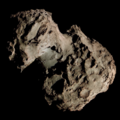41P/Tuttle–Giacobini–Kresák
 Comet 41P/Tuttle–Giacobini–Kresák on March 3, 2017 near Messier 108 and the Owl Nebula. | |
| Discovery | |
|---|---|
| Discovered by | Horace Parnell Tuttle Michel Giacobini Ľubor Kresák |
| Discovery date | May 3, 1858 |
| Designations | |
| P/1858 J1, P/1907 O1 P/1951 H1, P/1989b1 | |
| |
| Orbital characteristics[2][3] | |
| Epoch | September 13, 2023 (JD 2460200.5) |
| Observation arc | 72.38 years |
| Earliest precovery date | April 26, 1951 |
| Number of observations | 5,250 |
| Aphelion | 5.126 AU |
| Perihelion | 1.051 AU |
| Semi-major axis | 3.088 AU |
| Eccentricity | 0.65981 |
| Orbital period | 5.428 years |
| Inclination | 9.219° |
| 140.99° | |
| Argument of periapsis | 62.227° |
| Mean anomaly | 66.147° |
| Last perihelion | 12 September 2022 |
| Next perihelion | 15 February 2028[1] |
| TJupiter | 2.827 |
| Earth MOID | 0.134 AU |
| Jupiter MOID | 0.488 AU |
| Physical characteristics[2] | |
| Dimensions | 1.4 km (0.87 mi) |
| Comet total magnitude (M1) | 16.9 |
41P/Tuttle–Giacobini–Kresák is a periodic comet in the Solar System. The comet nucleus is estimated to be 1.4 km (0.87 mi) in diameter.[2]
Observational history
Discovery
Discovered by Horace Parnell Tuttle on May 3, 1858, and re-discovered independently by Michel Giacobini and Ľubor Kresák in 1907 and 1951 respectively, it is a member of the Jupiter family of comets.
2006 apparition
As of June 1, 2006, Comet 41P was a 10th magnitude object for telescopes, located on the Cancer-Leo border, with a predicted maximum of about 10 at perihelion on June 11. This comet is of interest as it has been noted to flare dramatically. In 1973 the flare was 10 magnitudes brighter than predicted, reaching easy naked-eye visibility at apparent magnitude 4.[4] However, by June 22, the comet had diminished to about magnitude 11, having produced no flare of note.
2011 apparition
The comet was not observed during the 2011 unfavorable apparition[5] since the perihelion passage occurred when the comet was on the far side of the Sun.
2017 apparition
41P was recovered on November 10, 2016, at apparent magnitude 21 by Pan-STARRS.[3] On April 1, 2017, the comet passed 0.142 AU (21.2 million km; 13.2 million mi) from the Earth.[6] The comet was expected to brighten to around magnitude 7 and be visible in binoculars.[7][8]
Proposed exploration
In the 1960s, the European Space Research Organisation investigated sending a probe to the comet.[9]
References
- ^ "Horizons Batch for 41P/Tuttle-Giacobini-Kresak (90000489) on 2028-Feb-15" (Perihelion occurs when rdot flips from negative to positive). JPL Horizons. Retrieved July 6, 2023. (JPL#K171/19 Soln.date: 2023-May-04)
- ^ a b c "41P/Tuttle–Giacobini–Kresák – JPL Small-Body Database Lookup". ssd.jpl.nasa.gov. Jet Propulsion Laboratory. Retrieved February 28, 2010.
- ^ a b "41P/Tuttle–Giacobini–Kresák Orbit". Minor Planet Center. Retrieved June 16, 2014.
- ^ G. W. Kronk. "41P/Tuttle–Giacobini–Kresák". Cometography.com. Retrieved April 23, 2025.
- ^ Seiichi Yoshida (July 22, 2011). "41P/Tuttle-Giacobini-Kresak (2011)". Seiichi Yoshida's Comet Catalog. Retrieved February 18, 2012.
- ^ "JPL Close-Approach Data: 41P/Tuttle-Giacobini-Kresak" (August 27, 2006 last obs). Archived from the original on December 13, 2012. Retrieved February 22, 2012.
- ^ Seiichi Yoshida (December 31, 2006). "41P/Tuttle-Giacobini-Kresak". Seiichi Yoshida's Comet Catalog. Retrieved February 28, 2010.
- ^ Bob King (January 4, 2017). "Bright Comet Prospects for 2017". Sky & Telescope. Retrieved March 2, 2017.
- ^ Ulivi, Paolo; Harland, David M (2007). Robotic Exploration of the Solar System Part I: The Golden Age 1957-1982. Springer. p. 89. ISBN 9780387493268.
External links
- 41P/Tuttle–Giacobini–Kresák at the JPL Small-Body Database
- 41P/Tuttle-Giacobini-Kresak at the Minor Planet Center's Database
- 41P at Kronk's Cometography


